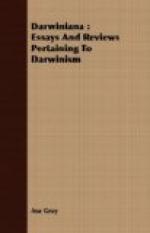To make such observations is as easy as it is interesting. Throughout the summer one has only to transfer plants of Drosera from the bogs into pots or pans filled with wet moss—if need be, allowing them to become established in the somewhat changed conditions, or even to put out fresh leaves—and to watch their action or expedite it by placing small flies upon the disk of the leaves. The more common round-leaved sundew acts as well as the other by its bristles, and the leaf itself is sometimes almost equally prehensile, although in a different way, infolding the whole border instead of the summit only. Very curious, and even somewhat painful, is the sight when a fly, alighting upon the central dew-tipped bristles, is held as fast as by a spider’s web; while the efforts to escape not only entangle the insect more hopelessly as they exhaust its strength, but call into action the surrounding bristles, which, one by one, add to the number of the bonds, each by itself apparently feeble, but in their combination so effectual that the fly may be likened to the sleeping Gulliver made fast in the tiny but multitudinous toils of the Liliputians. Anybody who can believe that such an apparatus was not intended to capture flies might say the same of a spider’s web.
Is the intention here to be thought any the less real because there are other species of Drosera which are not so perfectly adapted for fly-catching, owing to the form of their leaves and the partial or total want of cooperation of their scattered bristles? One such species, D. filiformis, the thread-leaved sundew, is not uncommon in this country, both north and south of the district that Dionaea locally inhabits. Its leaves are long and thread-shaped, beset throughout with glutinous gland-tipped bristles, but wholly destitute of a blade. Flies, even large ones, and even moths and butterflies, as Mrs. Treat and Mr. Canby affirm (in the American Naturalist), get stuck fast to these bristles, whence they seldom escape. Accidental as such captures are, even these thread-shaped leaves respond more or less to the contact, somewhat in the manner of their brethren. In Mr. Canby’s




